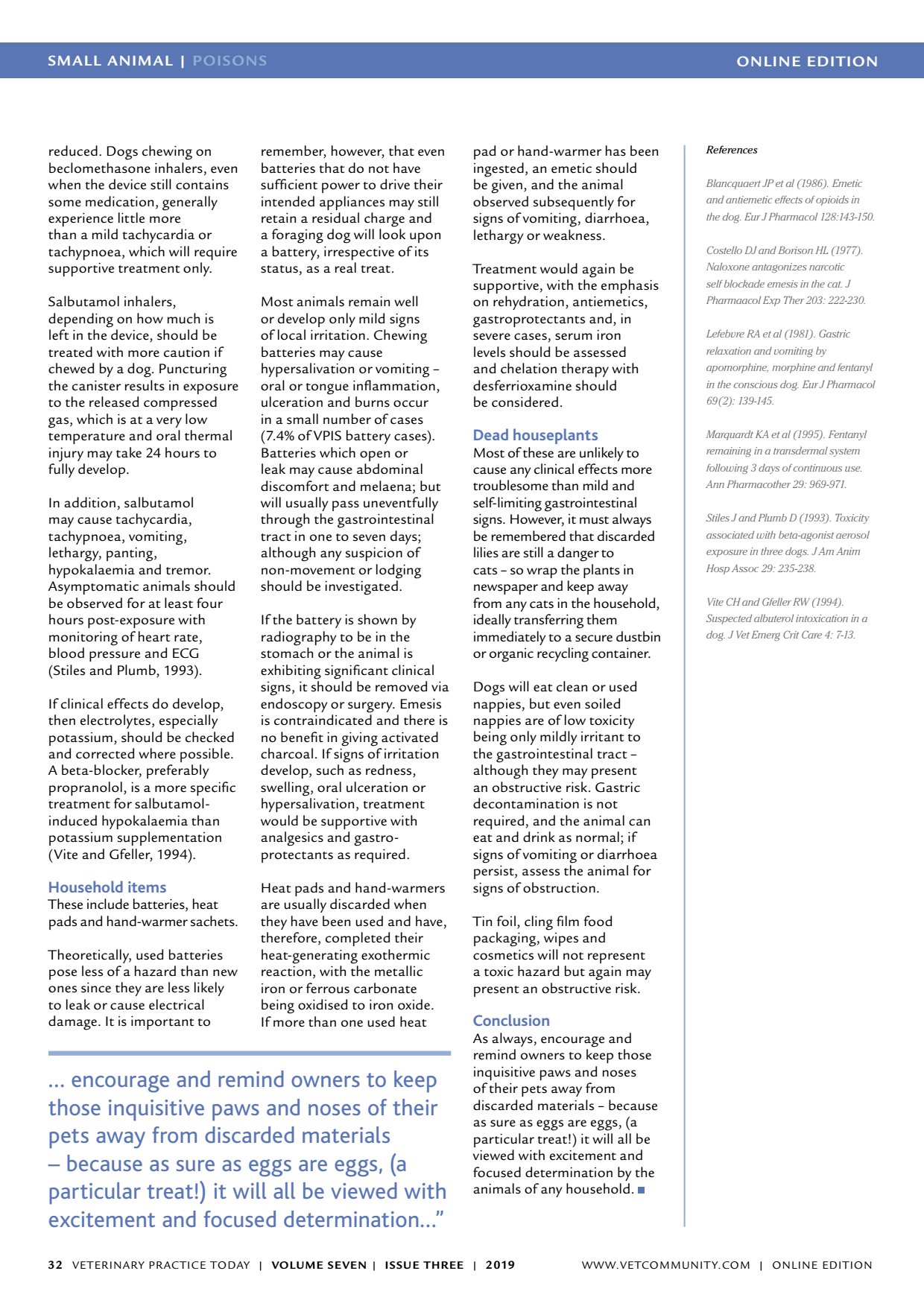Household items Dead
ONLINE EDITIONSMALL ANIMAL | POISONS VETERINARY PRACTICE TODAY | VOLUME SEVEN | ISSUE THREE | 2019 32 References Blancquaert JP et al (1986). Emetic and antiemetic effects of opioids in the dog. Eur J Pharmacol 128:143-150. Costello DJ and Borison HL (1977). Naloxone antagonizes narcotic self blockade emesis in the cat. J Pharmaacol Exp Ther 203: 222-230. Lefebvre RA et al (1981). Gastric relaxation and vomiting by apomorphine, morphine and fentanyl in the conscious dog. Eur J Pharmacol 69(2): 139-145. Marquardt KA et al (1995). Fentanyl remaining in a transdermal system following 3 days of continuous use. Ann Pharmacother 29: 969-971. Stiles J and Plumb D (1993). Toxicity associated with beta-agonist aerosol exposure in three dogs. J Am Anim Hosp Assoc 29: 235-238. Vite CH and Gfeller RW (1994). Suspected albuterol intoxication in a dog. J Vet Emerg Crit Care 4: 7-13. reduced. Dogs chewing on beclomethasone inhalers, even when the device still contains some medication, generally experience little more than a mild tachycardia or tachypnoea, which will require supportive treatment only. Salbutamol inhalers, depending on how much is left in the device, should be treated with more caution if chewed by a dog. Puncturing the canister results in exposure to the released compressed gas, which is at a very low temperature and oral thermal injury may take 24 hours to fully develop. In addition, salbutamol may cause tachycardia, tachypnoea, vomiting, lethargy, panting, hypokalaemia and tremor. Asymptomatic animals should be observed for at least four hours post-exposure with monitoring of heart rate, blood pressure and ECG (Stiles and Plumb, 1993). If clinical effects do develop, then electrolytes, especially potassium, should be checked and corrected where possible. A beta-blocker, preferably propranolol, is a more specific treatment for salbutamol- induced hypokalaemia than potassium supplementation (Vite and Gfeller, 1994). Household items These include batteries, heat pads and hand-warmer sachets. Theoretically, used batteries pose less of a hazard than new ones since they are less likely to leak or cause electrical damage. It is important to remember, however, that even batteries that do not have sufficient power to drive their intended appliances may still retain a residual charge and a foraging dog will look upon a battery, irrespective of its status, as a real treat. Most animals remain well or develop only mild signs of local irritation. Chewing batteries may cause hypersalivation or vomiting oral or tongue inflammation, ulceration and burns occur in a small number of cases (7.4% of VPIS battery cases). Batteries which open or leak may cause abdominal discomfort and melaena; but will usually pass uneventfully through the gastrointestinal tract in one to seven days; although any suspicion of non-movement or lodging should be investigated. If the battery is shown by radiography to be in the stomach or the animal is exhibiting significant clinical signs, it should be removed via endoscopy or surgery. Emesis is contraindicated and there is no benefit in giving activated charcoal. If signs of irritation develop, such as redness, swelling, oral ulceration or hypersalivation, treatment would be supportive with analgesics and gastro- protectants as required. Heat pads and hand-warmers are usually discarded when they have been used and have, therefore, completed their heat-generating exothermic reaction, with the metallic iron or ferrous carbonate being oxidised to iron oxide. If more than one used heat pad or hand-warmer has been ingested, an emetic should be given, and the animal observed subsequently for signs of vomiting, diarrhoea, lethargy or weakness. Treatment would again be supportive, with the emphasis on rehydration, antiemetics, gastroprotectants and, in severe cases, serum iron levels should be assessed and chelation therapy with desferrioxamine should be considered. Dead houseplants Most of these are unlikely to cause any clinical effects more troublesome than mild and self-limiting gastrointestinal signs. However, it must always be remembered that discarded lilies are still a danger to cats so wrap the plants in newspaper and keep away from any cats in the household, ideally transferring them immediately to a secure dustbin or organic recycling container. Dogs will eat clean or used nappies, but even soiled nappies are of low toxicity being only mildly irritant to the gastrointestinal tract although they may present an obstructive risk. Gastric decontamination is not required, and the animal can eat and drink as normal; if signs of vomiting or diarrhoea persist, assess the animal for signs of obstruction. Tin foil, cling film food packaging, wipes and cosmetics will not represent a toxic hazard but again may present an obstructive risk. Conclusion As always, encourage and remind owners to keep those inquisitive paws and noses of their pets away from discarded materials because as sure as eggs are eggs, (a particular treat!) it will all be viewed with excitement and focused determination by the animals of any household. encourage and remind owners to keep those inquisitive paws and noses of their pets away from discarded materials because as sure as eggs are eggs, (a particular treat!) it will all be viewed with excitement and focused determination WWW.VETCOMMUNIT Y.COM | ONLINE EDITION
